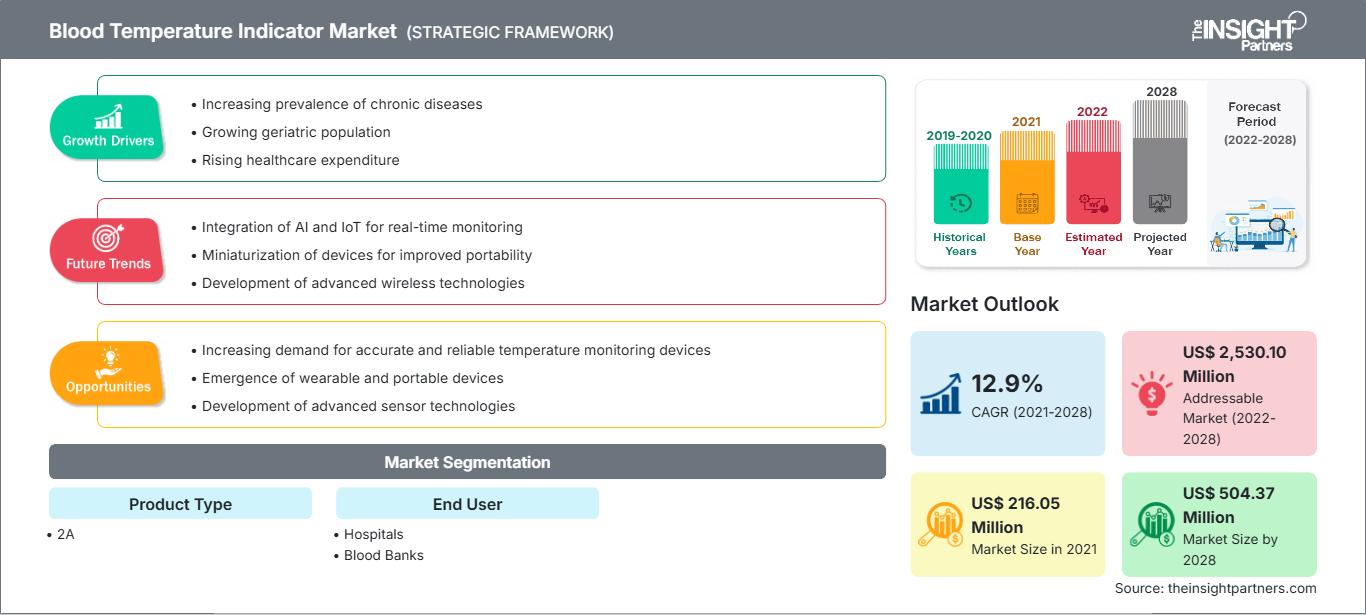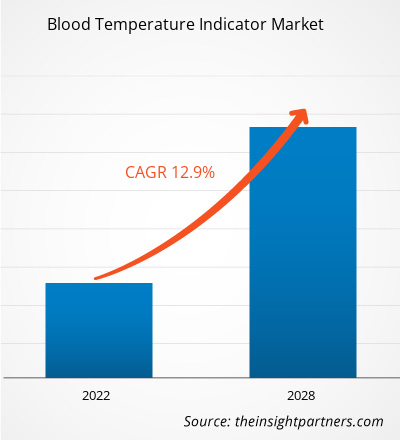Blood Temperature Indicator Market Growth Opportunities and Forecast by 2028
Historic Data: 2019-2020 | Base Year: 2021 | Forecast Period: 2022-2028Blood Temperature Indicator Market Forecast to 2028 - COVID-19 Impact and Global Analysis By Product Type (2°C to 4°C, 5°C to 7°C, and Above 7°C) and End User (Hospitals, Blood Banks, and Others)
- Report Date : May 2022
- Report Code : TIPRE00008207
- Category : Life Sciences
- Status : Published
- Available Report Formats :


- No. of Pages : 150
The blood temperature indicator market is expected to grow from US$ 216.05 million in 2021 to US$ 504.37 million by 2028; it is estimated to register a CAGR of 12.9% from 2021 to 2028.
Blood temperature indicators are small medical devices or solutions that help increase blood safety by effectively and efficiently transporting blood and blood components. These indicators provide auditable proof that blood is stored and transported as per regulatory standards, which further reduces blood waste.
The report provides insights and in-depth analysis of the blood temperature indicator market, emphasizing various parameters such as market trends, technological advancements, and market dynamics. It also provides the competitive landscape analysis of leading market players and the impact of the COVID-19 pandemic on the blood temperature indicator market across all major regions. The COVID-19 pandemic has disrupted the socioeconomic conditions of various countries across the world. As per the 2021 WHO statistics, the US is the world's worst-affected country due to the COVID-19 pandemic, with the highest number of COVID-19 cases. The high number of cases has hampered the economy of North America, especially the US. The COVID-19 pandemic has led to critical technological changes to provide better medical care. Due to the spread of SARS-CoV-2, many cities are being closed, resulting in treatment cancellations from doctors/surgeons. The COVID-19 Pandemic has affected the manufacturing and supply of blood temperature indicators owing to the disruption in supply chain globally. Additionally, healthcare professionals are prioritizing the emergency procedures and cancelled all the elective surgeries to prevent the spread of coronavirus.
In 2020, the Food and Drug Administration (FDA) allowed the emergency use of convalescent plasma for the treatment of COVID-19 patients, leading to an increase in blood donation. Further, the presence of major market players and their various strategic collaborations in the blood temperature indicator market is expected to support market growth. For instance, Timestrip, the developer of smart indicator technology, is launching a completely new range with two electronic temperature indicators. These indicators will be critical in monitoring the safe storage and transportation of various goods, including pharmaceuticals, vaccines, healthcare, food produce, adhesives, and inks. Thus, the COVID-19 pandemic adversely affected the blood temperature indicator market.
Based on region, the blood temperature indicator market is segmented into North America, Europe, Asia Pacific, the Middle East & Africa, and South & Central America.
Customize This Report To Suit Your Requirement
You will get customization on any report - free of charge - including parts of this report, or country-level analysis, Excel Data pack, as well as avail great offers and discounts for start-ups & universities
Blood Temperature Indicator Market: Strategic Insights

-
Get Top Key Market Trends of this report.This FREE sample will include data analysis, ranging from market trends to estimates and forecasts.
Market Insights
Increase in Blood Transfusion and Donation Drives Blood Temperature Indicator Market
Blood transfusion is one of the commonly used procedures in healthcare, which helps maintain the blood level of patients. There are various chronic conditions, surgical procedures, and trauma cases that require blood transfusion so that patients can survive without any side effects due to low blood levels. Medical conditions, including thalassemia, blood cancer, sickle cell anemia, anemia, and surgical and trauma cases, lead to blood loss and require a blood transfusion. According to the American Red Cross organization, ~16 million blood components are transfused each year in the US. Further, sickle cell anemia affects 90,000‒100,000 people in the US; ~1,000 babies are born with this disease each year. Thus, the increasing prevalence of chronic diseases has created the demand for blood transfusion, which is expected to propel the growth of the blood temperature indicator market.
After collection, blood should be stored and transported under specific conditions and temperatures. If the blood is stored and transported outside the specific temperature range for a prolonged time, it loses its ability to carry oxygen, which can cause serious problems. Further, there is a risk of severe bacterial contamination if the blood is exposed to warm temperatures. Blood temperature indicators play an important role in maintaining the required conditions and temperature for the safe and reliable transportation of blood and its components. It reduces the chances of blood spoilage by closely monitoring the temperature and keeping the blood safe during transportation. Thus, increasing blood transfusion, blood donation, and rising demand for safe transportation of blood and its component creates demand for blood temperature indicators, which drives the market growth.
Product Type-Based Insights
Based on product type, the blood temperature indicator market is segmented into 2°C to 4°C, 5°C to 7°C, and above 7°C. In 2021, the 2°C to 4°C segment accounted for the largest market share. The market position of this segment has increased due to its major use during long route transportation of blood. For instance, as per major European and American guidelines, the temperature of RBC bags must range from 1°C to 6°C while storing it, and from 1°C to 10°C while carrying.
Blood Temperature Indicator Market Regional InsightsThe regional trends and factors influencing the Blood Temperature Indicator Market throughout the forecast period have been thoroughly explained by the analysts at The Insight Partners. This section also discusses Blood Temperature Indicator Market segments and geography across North America, Europe, Asia Pacific, Middle East and Africa, and South and Central America.
Blood Temperature Indicator Market Report Scope
| Report Attribute | Details |
|---|---|
| Market size in 2021 | US$ 216.05 Million |
| Market Size by 2028 | US$ 504.37 Million |
| Global CAGR (2021 - 2028) | 12.9% |
| Historical Data | 2019-2020 |
| Forecast period | 2022-2028 |
| Segments Covered |
By Product Type
|
| Regions and Countries Covered |
North America
|
| Market leaders and key company profiles |
|
Blood Temperature Indicator Market Players Density: Understanding Its Impact on Business Dynamics
The Blood Temperature Indicator Market is growing rapidly, driven by increasing end-user demand due to factors such as evolving consumer preferences, technological advancements, and greater awareness of the product's benefits. As demand rises, businesses are expanding their offerings, innovating to meet consumer needs, and capitalizing on emerging trends, which further fuels market growth.

- Get the Blood Temperature Indicator Market top key players overview
End User Insights
Based on end user, the blood temperature indicator market is segmented into hospitals, blood banks, and others. The hospitals segment dominated the market in 2021.
The blood temperature indicator market players adopt organic strategies such as product launch and expansion to expand their footprint and product portfolio globally.
Company Profiles
- Elitech
- Thero Fisher Scientific Inc.
- Sercalia
- Ellab Group
- Zebra Technologies Corporation
- Lisaline Lifesceinces Technologies
- Stream Peak International PTE Ltd
- 3M
- DeltaTrak Inc.
- TimeStrip UK Ltd
Frequently Asked Questions
What is the regional market scenario of the blood temperature indicator market?
Who are the key players in the blood temperature indicator market?
Which end user segment held the largest revenue (US$ Mn) in the blood temperature indicator market?
What is meant by the blood temperature indicator market?
What are the driving factors for the blood temperature indicator market across the globe?
Which segment led the blood temperature indicator market?
Mrinal is a seasoned research analyst with over 8 years of experience in Life Sciences Market Intelligence and Consulting. With a strategic mindset and unwavering commitment to excellence, she has built deep expertise in pharmaceutical forecasting, market opportunity assessment, and developing industry benchmarks. Her work is anchored in delivering actionable insights that empower clients to make informed strategic decisions.
Mrinal’s core strength lies in translating complex quantitative datasets into meaningful business intelligence. Her analytical acumen is instrumental in shaping go-to-market (GTM) strategies and uncovering growth opportunities across the pharmaceutical and medical device sectors. As a trusted consultant, she consistently focuses on streamlining workflow processes and establishing best practices, thereby driving innovation and operational efficiency for her clients.
- Historical Analysis (2 Years), Base Year, Forecast (7 Years) with CAGR
- PEST and SWOT Analysis
- Market Size Value / Volume - Global, Regional, Country
- Industry and Competitive Landscape
- Excel Dataset
Recent Reports
Related Reports
Testimonials
The Insight Partners' SCADA System Market report is comprehensive, with valuable insights on current trends and future forecasts. The team was highly professional, responsive, and supportive throughout. We are very satisfied and highly recommend their services.
RAN KEDEM Partner, Reali Technologies LTDsI requested a report on a very specific software market and the team produced the report in a few days. The information was very relevant and well presented. I then requested some changes and additions to the report. The team was again very responsive and I got the final report in less than a week.
JEAN-HERVE JENN Chairman, Future AnalyticaWe worked with The Insight Partners for an important market study and forecast. They gave us clear insights into opportunities and risks, which helped shape our plans. Their research was easy to use and based on solid data. It helped us make smart, confident decisions. We highly recommend them.
PIYUSH NAGPAL Sr. Vice President, High Beam GlobalThe Insight Partners delivered insightful, well-structured market research with strong domain expertise. Their team was professional and responsive throughout. The user-friendly website made accessing industry reports seamless. We highly recommend them for reliable, high-quality research services
YUKIHIKO ADACHI CEO, Deep Blue, LLC.This is the first time I have purchased a market report from The Insight Partners.While I was unsure at first, I visited their web site and felt more comfortable to take the risk and purchase a market report.I am completely satisfied with the quality of the report and customer service. I had several questions and comments with the initial report, but after a couple of dialogs over email with their analyst I believe I have a report that I can use as input to our strategic planning process.Thank you so much for taking the extra time and making this a positive experience.I will definitely recommend your service to others and you will be my first call when we need further market data.
JOHN SUZUKI President and Chief Executive Officer, Board Director, BK TechnologiesI wish to appreciate your support and the professionalism you displayed in the course of attending to my request for information regarding to infectious disease IVD market in Nigeria. I appreciate your patience, your guidance, and the fact that you were willing to offer a discount, which eventually made it possible for us to close a deal. I look forward to engaging The Insight Partners in the future, all thanks to the impression you have created in me as a result of this first encounter.
DR CHIJIOKE ONYIA MANAGING DIRECTOR, PineCrest Healthcare Ltd.Reason to Buy
- Informed Decision-Making
- Understanding Market Dynamics
- Competitive Analysis
- Identifying Emerging Markets
- Customer Insights
- Market Forecasts
- Risk Mitigation
- Boosting Operational Efficiency
- Strategic Planning
- Investment Justification
- Tracking Industry Innovations
- Aligning with Regulatory Trends




















 Get Free Sample For
Get Free Sample For